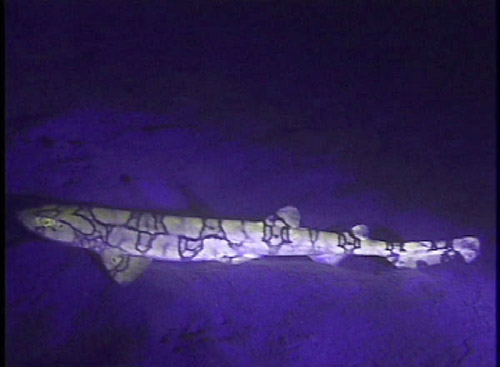False Cat Shark

Common Name: False Cat Shark
Scientific Name: Pseudotriakis microdon
False Cat Shark - Description
A new specimen of a rare deepwater chondrichthyan, the false catshark Pseudotriakis microdon Capello, 1868 is documented from the Coral Sea.It is possibly a cosmopolitan deepwater elasmobranch, however, it is sporadically recorded and its complete distribution remains unclear. The false catshark is benthic, primarily on the continental and insular slopes at depths of 200-1,900m.
False Cat Shark - Nature
Pseudotriakis microdon is a monospecific genus, characterised by its large adult size, soft-body, cat-like eyes and nictitating eyelids, large spiracles, wide angular mouth extending posterior to the eye, two large spineless dorsal fins, the first low, extended and keel-like, an anal fin, numerous extremely small cuspidate teeth.The growth of the Cat Shark is upto 10 feet in length.The specimen, a 277cm total length (TL) mature male, was captured by exploratory deepwater dropline at a depth of 350m on 03/02/2004.A further individual, a 287cm TL mature female captured by bottom longline operating at depths of 100-150m around Sawu, Dana and Raijua Islands, southeastern Indonesia.
False Cat Shark - food
The False Cat Shark eats shrimp, octopus, fishes (including sharks).
False Cat Shark - Habitat
Bottom-dweller at depths of about 600 to 5,000 ft.Most records are from the Northern Hemisphere, and the species appears to be rarer, or more rarely encountered, in the Southern Hemisphere.Some of the places where they were recorded are the northwest Atlantic, off Canada (Gilhen & Coad, 1999) and New York to New Jersey (Bigelow & Schroeder, 1948),northeast and eastern central Atlantic from the Atlantic slope off Iceland, France, Portugal, Madeira, Azores to Senegal,etc,.,
False Cat Shark - Reproduction
Aplacental vivipary, embryos feed on eggs in uterus after using up yolk sac; litter size normally 2; The size of False Cat Shark at maturity 6.5 ft for males, 7 ft for females approximately.
False Cat Shark - Research
The research on False Cat Shark is being done because of the uncleared view on it.Pseudotriakis acrales (from the Atlantic) as distinct from Pseudotriakis microdon (from the Pacific) however numerous authors (see Compagno, 1988 for an account) could not find any characters to reliably separate the two species and tentatively placed P. acrales in synonymy with P. microdon. Yano& Musick (1992) confirmed this synonymy with morphometric analysis, concluding that characters used to separate the species change allometrically as suggested by Compagno (1988).The Pseudotriakidae also includes Gollum Compagno, 1973; the two genera being readily distinguished by the height of the first dorsal fin. In Gollum the first dorsal fin is about the same size as, and is roughly equal in height to, the second dorsal fin (Compagno,1973), whilst in Pseudotriakis the low, keel-like first dorsal fin is much lower than the second dorsal fin.
 Deep Sea Crabs
Deep Sea Crabs